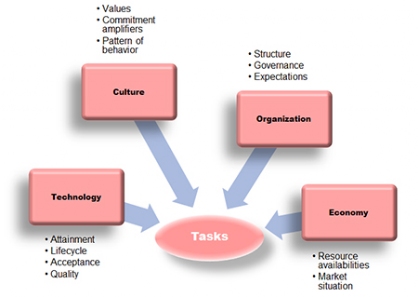Influence factor model
External factors affect business tasks. These so-called influence factors require special attention in the planning and realization of tasks and projects to ensure successful conclusion and to prevent unwanted surprises. The influence categories bundle factors (e.g. values, expectations) that unconsciously impact the doing of each participant. These factors affect by subtly suggesting solutions. For example in an institutionalized decision-making process, alternative ways of decision-making are not considered. The categories are long-term aspects like culture, medium term aspects like organization, and short-term aspects like economy. Technology has a special role, because it comprises long-, mid- and short-term influences. Each area consists of influence factors, which can be further detailed and expanded.
The influence factor model consists of four categories (culture, organization, economy and technology) that are explained in the following.

Culture
Culture is an influence category that emerges during a longer period and is valid for specific organizations, societies and cultures. Cultural influence factors, like values, commitment amplifiers and behavior patterns, are valid across organizational borders. They are covered by organizational influence factors and seem to be suppressed into the background. They persist subconsciously and create thereby intangible resistance that has to be resolved with huge organizational effort. They promote common identity, co-operation and behavior standards and often inhibit change. For intercultural projects, it is highly suggested to recognize the related cultures.
Organization
Organizational influence factors result from the self-understanding of an organization. Structures that describe roles as well as elements of governance (e.g. principles, guidelines, strategy) are defined, which have direct and indirect influence. Beyond that, every organization has a variety of expectations that are usually not documented (e.g. conventions and opinions). To consider expectations requires special efforts, in order to be recognize (e.g. dialogue with all participants). The organizational influence factors are developed within the respective organization. For inter-organizational projects, it is highly suggested to recognize the related organizational influence factors.
Economy
Economy describes the factors that define economical limits. At first view, they are considered restricting factors. In reality, the specification of the economic conditions often extends the scope of action. It helps to describe these factors explicitly, in order to avoid self-restraint, which results from assumptions and anticipatory obedience. The relevant economic factors are internal resources (people, material, infrastructure and capital) and the external market situation (e.g. customer behavior, supplier market, competitive position). The pro-active review of the economic influence factors ensures the use of the available resources.
Technology
Technology plays a special role in today's tasks, since as an important element of the business solution it exerts a very large power of influence. It enables new business models and solution types. However, it can obligate the participants to stay for a long time with a solution due to its life cycle and its integration into the landscape. Information Technology penetrates strongly business with its application and infrastructure coverage. Nevertheless, in other technological areas new technologies emerge more and more as success factor, e.g. in the medicine or environmental technology. The influence factors achievement and life cycle are rather measurable and objective. Acceptance and quality are subjective influence factors that need special approaches (e.g. public surveys). Due to the long-term effects of technology the current infrastructure and, for new technologies, the upcoming, long-term impact should be reviewed.
The present model covers substantial influence factors, but might not cover all influences. Therefore, ask regularly the following question: Are there further influence factors that are not considered yet?
